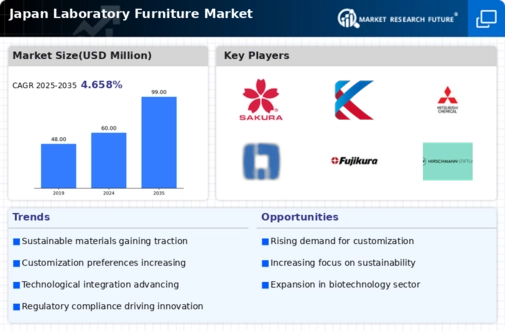Growing Demand for Customizable Solutions
The laboratory furniture market is witnessing a growing demand for customizable solutions tailored to specific laboratory needs. As research environments become more specialized, laboratories require furniture that can be adapted to various workflows and equipment. This trend is particularly evident in Japan, where customization is often prioritized to enhance operational efficiency. Manufacturers are responding by offering modular furniture systems that can be easily reconfigured, allowing laboratories to optimize their layouts. This flexibility is expected to drive market growth, as laboratories seek to create spaces that are not only functional but also conducive to collaboration and innovation.
Regulatory Compliance and Safety Standards
The laboratory furniture market is significantly influenced by stringent regulatory compliance and safety standards in Japan. Laboratories are required to adhere to various safety regulations, which often necessitate the use of specialized furniture designed to minimize hazards. For example, the Japanese Industrial Standards (JIS) set forth guidelines that impact the design and materials used in laboratory furniture. As a result, manufacturers are increasingly focusing on producing furniture that meets these standards, which is likely to drive market growth. The emphasis on safety and compliance not only enhances the functionality of laboratory spaces but also ensures the well-being of personnel, thereby reinforcing the importance of quality laboratory furniture.
Sustainability Initiatives in Laboratory Design
The laboratory furniture market is increasingly influenced by sustainability initiatives aimed at reducing environmental impact. In Japan, there is a growing awareness of the need for eco-friendly materials and practices in laboratory design. This shift is prompting manufacturers to develop furniture made from sustainable materials, such as recycled plastics and responsibly sourced wood. The emphasis on sustainability is not only a response to consumer demand but also aligns with government policies promoting green practices. As laboratories strive to minimize their carbon footprint, the laboratory furniture market is likely to see a rise in demand for sustainable solutions that meet both functional and environmental criteria.
Increased Investment in Research and Development
The laboratory furniture market is benefiting from increased investment in research and development (R&D) across various sectors, including pharmaceuticals, biotechnology, and academic institutions. In Japan, R&D spending has seen a consistent rise, reaching approximately $170 billion in 2025. This surge in funding is driving the establishment of new laboratories and the renovation of existing ones, thereby increasing the demand for high-quality laboratory furniture. As organizations seek to create optimal working environments for researchers, the laboratory furniture market is expected to grow in tandem, with a focus on durable and versatile furniture solutions that meet the specific needs of modern laboratories.
Technological Advancements in Laboratory Equipment
The The market is experiencing a notable shift due to rapid technological advancements in laboratory equipment. is experiencing a notable shift due to rapid technological advancements in laboratory equipment. Innovations such as automated systems and integrated digital solutions are driving the demand for specialized furniture that accommodates these technologies. For instance, the integration of smart lab technologies necessitates furniture that can support advanced equipment, which is projected to grow at a CAGR of 6.5% in the coming years. This trend indicates a growing need for adaptable and modular furniture solutions that can easily accommodate evolving laboratory setups. As laboratories in Japan increasingly adopt these technologies, the laboratory furniture market is likely to expand, reflecting the need for furniture that enhances functionality and efficiency.



















Leave a Comment